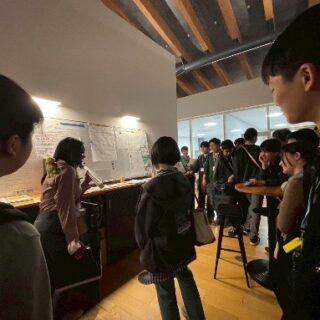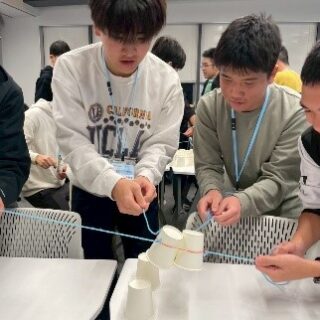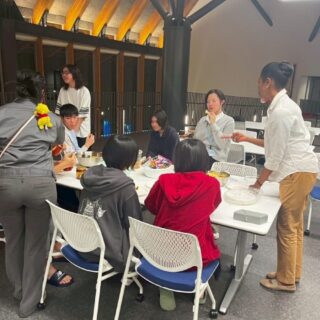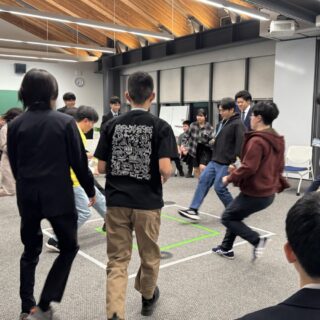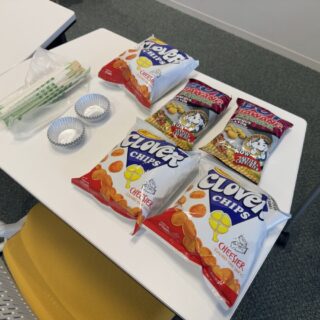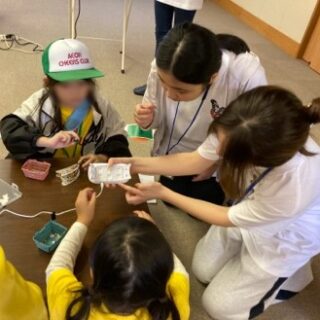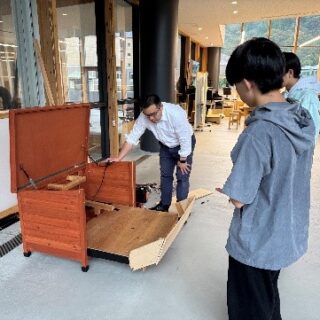Hakusanroku
白山麓キャンパス
 白山麓キャンパスに積もっていた雪が溶け、小さな春の蕾の開花とともに、ここに集まった新入生たちも新たな門出の日を迎えました!
白山麓キャンパスに積もっていた雪が溶け、小さな春の蕾の開花とともに、ここに集まった新入生たちも新たな門出の日を迎えました!
こんにちは。ラーニングメンターのドミソン・アブワンです。私たちラーニングメンターは主に、白山麓キャンパスで学校生活を送る1・2年生と共に活動します。2025年4月、ここ白山麓キャンパスでは、新たな学び、成長、生活への旅路に立った新入生たちを歓迎しました。
平日の19:30~21:30まで、勉強や宿題、学習習慣を身につけるための「ラーニングセッション」を開催しています。もちろん、私たちラーニングメンターはそこで学習指導やサポートしたり、時には親身になって話をしたりします。
新入生がこの新しい環境に溶け込み、友達を作り、新学期をスタートできるよう、私たちは、楽しく充実した時間になるようなイベントを企画しました。
ラーニングセッション オリエンテーションからスタート
4月4日(金)、1・2年生がラーニングセッションのオリエンテーションに参加しました。私たちラーニングメンターは自己紹介をし、ラーニングセッションについて説明をしました。通常の授業と同じようにラーニングセッションもガイドラインに沿って、夜の時間を有効に使います。
その中で大切なことは、そう英語です!ラーニングセッションの時間は英語を使用し、3年生でのニュージーランド留学に備えて英語での生活に慣れることができるのです。
また、今年の新しいアクティビティーとして、学生の現在の英語レベルに合わせた記事を読み、質問に答えることで読解力を磨く「リーディング・ラボラトリー」を導入することとなりました。
その後は、1年生を対象にラーニングセッションで活用する場所について案内を行いました。アナウンスの掲示場所、学習資料の場所、静かな学習やグループワーク、ワークショップに使われる部屋などを簡単に紹介しました。
続いては、楽しみにしていた時間です。
ゲームや笑い合いを通して打ち解ける
オリエンテーションの部屋に戻り、チームビルディングゲームが始まりました!始めに「カップスタックチャレンジ」を行いました。これは少人数のグループに分かれ、紐付きの輪ゴム(1人につき1本)だけを使って、紙コップを積み上げて一番高いタワーを作り上げるゲームです。ハイペースで3回戦まで行われ、会場は笑いと歓声に包まれ、時にはハラハラする場面もあり、大いに盛り上がりました。優勝者にはもちろん賞品のお菓子が贈られました!
次は、趣味や興味のあることを質問する英語でのビンゴです。このゲームの目的は、できるだけ多くの学生と会話をし、ビンゴシートを完成させることです。最適なアイスブレイクとなり、全員が英語で会話や質問をし、お互いの共通点に気づくことができました。
最後に、学生たちはグループに分かれてSTEM(理科科目)に関する課題に取り組みました。これは、次回の化学の授業で行われる小テストに向けた課題です。化学実験室の安全性と器具の適切な使用法に関する問題を解きました。楽しい時間を過ごした後も、学生たちが協力し合い、集中力を発揮していた様子は素晴らしかったです。
グループへようこそ!
4月9日(水)、ラーニングセッションのグループ割りが発表され、学生たちは興奮に包まれました!ホグワーツ魔法魔術学校のような雰囲気ですが、魔法の呪文の代わりに宿題によってポイントが課されます。学生たちが自分のグループを見つけるたびに、(「やった!同じだ!」と)笑いと驚きの声が聞こえてきました。
一方で2年生はベテランとなり、宿題や課題をこなして、すぐに各グループのポイント獲得に取り組みました。学期末には、最も多くのポイントを獲得したグループに賞と賞品が贈られます。切磋琢磨の始まりです!
カラオケ、ボードゲーム、みんなの笑顔
4月11日(金)は新入生のために正式な歓迎会を開きました。2年生は頼もしく、ゲームの準備を手伝い、カラオケのスタートを切ってくれました!
学生たちは一人ずつマイクを手に取り、お気に入りのヒット曲を歌いました。ソロで歌う学生や、グループで歌う学生もいれば、一緒に踊ったり、会場は活気とたくさんの笑い声で溢れていました。
ボードゲーム、カードゲーム、積み上げゲームもあり、どのゲームも歓声が沸き起こりました。コンピューターゲームにも大勢の学生が集まり、あっという間にまるで以前から友達だったかのように絆を深めていました。
歓迎会では、私たち教員もそれぞれの学生と、新生活の様子や今学期で楽しみにしていることなどを、お菓子をつまみながら和やかな雰囲気の中で気軽に英語で会話をすることができました。
“スペシャル”への飛躍
ラーニングメンターが企画したこれらのアクティビティーが、新入生たちへの温かい歓迎と、白山麓キャンパスでの新生活の力強いスタートとなれれば嬉しく思います。新学期を始めるにあたり、これからラーニングセッションの時間にワークショップ、季節のイベント、楽しくグループチャレンジを開催していくことを楽しみにしています。
今後も続きをお伝えしていきますね。
ドミソン・アブワン

As the last patches of snow melted from the Hakusanroku campus grounds and tiny buds of spring began to bloom, something else started fresh, too—our newest batch of freshmen!
Hi, I’m Domyson Abuan, one of the Learning Mentors (LMs) here at ICT, and our team works closely with both 1st and 2nd year students. This April 2025, we opened our doors to welcome the incoming students who are just beginning their journey of learning, growing, and living here at the Hakusanroku campus.
Each weeknight from 7:30 P.M. to 9:30 P.M., we run Learning Sessions (LS)—a time dedicated to studying, doing homework, and building good study habits for students. And of course, us LMs are there to guide, support, and sometimes, just be a friendly face to talk to.
To help our 1st year students ease into this new environment, we planned some fun and meaningful events to help them meet their schoolmates, and get a head start on the semester.
Kicking Things Off: Learning Session Orientation
On Friday, April 4th, both 1st and 2nd year students gathered for our LS Orientation. We LMs introduced ourselves and gave a quick rundown of what the session is all about. Just like their morning classes, LS has a set of guidelines so everyone knows how to make the most of their evenings.
One important part? English time! Students are encouraged to use English during LS so they can get used to it in preparation for their life in New Zealand when they are 3rd year students.
We also introduced this year’s new activity: a Reading Laboratory where students read an article suited to their current level and answer a few questions to sharpen their reading comprehension.
Afterwards, the 1st year students were given a short tour around the LS spaces—like where to find the announcements, where to grab study materials, and which rooms are used for quiet study and group work.
Then, the real fun began.
Games, Giggles, and Getting to Know Each Other
Back in the orientation room, it was time for some team-building games! First up was the Cup Stack Challenge. Divided into small groups, students had to work together using only a rubber band with strings (one per teammate) to stack paper cups into the tallest tower. With three rounds of fast-paced building, the room was filled with laughter, cheering, and a few dramatic cup crashes. Winners, of course, got snack prizes!
Next was English Bingo, with questions about hobbies and personal interests. The goal? Talk to as many classmates as possible to complete your bingo sheet. It was a great icebreaker and got everyone chatting in English, asking questions, and realizing they already have things in common.
To wrap things up, students worked together in groups to complete their STEM (Science subject) worksheets—an actual study task to help them prep for an upcoming quiz in their Chemistry class. They answered questions on laboratory safety and proper use of apparatus. We were really proud of how well they collaborated and focused, even after all the fun.
Welcome to the House System!
On Wednesday, April 9th, excitement was in the air as the students were sorted into their Houses! Think Hogwarts vibes, but with homework points instead of magic spells. As each student discovered their house, you could hear laughter and surprise (“Yay! I'm with you!”) across the room.
Meanwhile, the 2nd years, now seasoned pros, jumped right into earning points for their houses by completing homework and doing tasks. At the end of semester, the house with the most points wins the House Cup and a special reward. Let the friendly competition begin!
Karaoke, Board Games, and Bright Smiles
To officially welcome the new students, we held a Welcome Party on Friday, April 11th. The 2nd years really stepped up—they helped set up games and even kicked off the karaoke session!
One by one, students took the mic and sang their favorite hits. Many sang solo, some in groups, and others danced along. The room buzzed with energy and lots of laughter.
There were board games, card games, and stacking challenges too—each bringing out bursts of cheers. A computer game even pulled a huge crowd, and before long, many were playing and bonding like old friends.
Throughout the party, us teachers made our rounds, casually chatting with students in English about how they were settling in and what they looked forward to the most this semester - the chats were made more fun of course by delicious snacks.
A Springboard into Something Special
We hope these activities gave our freshmen a warm welcome and a strong start to their life here at Hakusanroku campus. With a new semester ahead, we're excited for more workshops, holiday events, and fun group challenges during our Learning Sessions.
And yes—we’ll definitely keep you posted.
Domyson Abuan
 こんにちは。白山麓高専事務室の間加田 侑里です。白山麓キャンパスでは24名の新入生を迎え、学生たちは新たなキャンパスライフに慣れてきた様子です。さて、今回は2025年4月1日(火)の入学式後に開催された1・2年生合同の「アイスブレイク」について紹介します。
こんにちは。白山麓高専事務室の間加田 侑里です。白山麓キャンパスでは24名の新入生を迎え、学生たちは新たなキャンパスライフに慣れてきた様子です。さて、今回は2025年4月1日(火)の入学式後に開催された1・2年生合同の「アイスブレイク」について紹介します。
まず初めに、「Identity Crisis」というゲームが行われました。ラーニングメンターから、1・2年生それぞれの名前が書かれた紙が、学生一人ひとりに配られ、学生たちはその紙に書かれている人物を探し出すというミッションに挑戦しました。さらに、椅子の裏にも学生の名前が書かれている紙が貼ってあり、最後には「自分の名前が書かれた椅子を見つけて座る」という課題もありました。
ゲームが始まると、学生たちはお互いに自己紹介をしながら、紙に書かれた人物を探し始めました。自分の名前が書かれた紙を持っている相手を見つけるのには少し時間がかかっていましたが、相手が自分の名前を見つけた瞬間には大きな笑顔を見せ、その瞬間は大いに盛り上がりました。また、学生同士が声を掛け合ったり協力し合ったりしながら、自分の名前が書かれた椅子を探している姿も印象的でした。
-
Students introduced themselves to each other and checked whether the other person was holding the paper with their name on it.自己紹介し合い、相手が自分の名前が書かれた紙を持っているか確認
-
Checking names under the chairs. 椅子の裏の名前を確認
-
Found his name under a chair.椅子の裏に自分の名前を発見!
 次に、「In the Box」というゲームが行われました。これは、お互いの共通点や趣味を見つけることを目的としたものです。まず、学生たちは自分の趣味や出身地、好きな食べ物、得意なことなどを紙に書きました。その後、ラーニングメンターがその紙を回収し、内容を一つずつ読み上げました。学生たちは、読み上げられた内容と自分に共通点があった場合、中央の枠に向かって走り出しました。
次に、「In the Box」というゲームが行われました。これは、お互いの共通点や趣味を見つけることを目的としたものです。まず、学生たちは自分の趣味や出身地、好きな食べ物、得意なことなどを紙に書きました。その後、ラーニングメンターがその紙を回収し、内容を一つずつ読み上げました。学生たちは、読み上げられた内容と自分に共通点があった場合、中央の枠に向かって走り出しました。
枠は二重になっており、外側の枠に入ると1コイン、中央の枠に入ると2コインがもらえるというルールでした。学生たちが書いた内容は「本を読むのが好き」、「ペンギンが好き」、「国際高専が好き」など、さまざまな情報が読み上げられる中、「ノルウェー出身」や「インドネシア出身」といった内容が出ると、学生たちからは拍手がおこったり、和やかな雰囲気になりました。
最後に、コインの数が多かった3名の学生にはお菓子がプレゼントされました。
アイスブレイクを通して、学生たちはお互いのことを知るきっかけをつかむことができたようです。
@ictkanazawa 2025年4月1日(火)、白山麓キャンパス(1、2年生)でアイスブレイクが行われ、共通点を見つけるゲームが実施されました👀✨緑の枠に入ると2ポイント、白い枠に入ると1ポイント付与され、ポイントの多い3名にはお菓子がプレゼントされました🍫🍪 学生たちは、アイスブレイクを通して、お互いを知ることができたのではないでしょうか✨ #国際高専
♬ ABC - Jackson 5
-
Write down hobbies, hometowns, favorite foods, special skills on a piece of paper.紙に自分の趣味や出身地、好きな食べ物、得意なことなどを記入
-
Run to the center box!自分に共通点があった場合、中央の枠に向かって走り出しました!
-
Get in the box!枠の中に入ります!
-
Received a coin!コインゲット!
-
The three winters!コインが多かった3名の学生!
間加田 侑里
 Hello! This is Yuri Makada from the Hakusanroku office. At ICT, 24 new students have arrived and are beginning to settle into their new campus life. This time, I would like to write the icebreaker activities held on Tuesday, April 1st, 2025, after the entrance ceremony.
Hello! This is Yuri Makada from the Hakusanroku office. At ICT, 24 new students have arrived and are beginning to settle into their new campus life. This time, I would like to write the icebreaker activities held on Tuesday, April 1st, 2025, after the entrance ceremony.
The first activity was a game called "Identity Crisis." Learning mentors handed out slips of paper to each student, with the name of another 1st and 2nd year student written on it. The mission was to find the person whose name was written on the paper. In addition, pieces of paper with students' names were also hidden under the chairs. At the end of the game, students had to find the chair with their own name written underneath and sit on it.
As the game began, students introduced themselves to each other while searching for the person on their paper. It took some time to find one another, but once they found their name, they seemed really happy with big smiles and the atmosphere became lively and cheerful.
It was also memorable to see students calling out to one another and then working together to find the chair with their own name on it.
-
Students introduced themselves to each other and checked whether the other person was holding the paper with their name on it.自己紹介し合い、相手が自分の名前が書かれた紙を持っているか確認
-
Checking names under the chairs. 椅子の裏の名前を確認
-
Found his name under a chair.椅子の裏に自分の名前を発見!
Next, a game called “In the Box” was held. The purpose of this was to find commonalities and hobbies among each other. First, students wrote their hobbies, hometowns, favorite foods, specialties, etc. on a piece of paper. The Learning Mentors then collected the papers and read out the contents one by one. If the students found something they had in common with what was read, they ran toward the center of the room.
In the center of the room, there were two tape outlines in the shape of 2 boxes, with the rule that if they entered the outer box, they received one coin, and if they entered the inter box, they received two coins. The students wrote a variety of information, such as “I like reading books,” “I like penguins,” “I like ICT,” etc. When information such as “I'm from Norway” or “I'm from Indonesia” was shared, the students responded with applause, creating a warm and friendly atmosphere.
At the end of the session, the three students with the highest number of coins were presented with snacks!
Through the icebreakers, the students seemed to be able to get to know each other better.
@ictkanazawa 2025年4月1日(火)、白山麓キャンパス(1、2年生)でアイスブレイクが行われ、共通点を見つけるゲームが実施されました👀✨緑の枠に入ると2ポイント、白い枠に入ると1ポイント付与され、ポイントの多い3名にはお菓子がプレゼントされました🍫🍪 学生たちは、アイスブレイクを通して、お互いを知ることができたのではないでしょうか✨ #国際高専
♬ ABC - Jackson 5
-
Write down hobbies, hometowns, favorite foods, special skills on a piece of paper.紙に自分の趣味や出身地、好きな食べ物、得意なことなどを記入
-
Run to the center box!自分に共通点があった場合、中央の枠に向かって走り出しました!
-
Get in the box!枠の中に入ります!
-
Received a coin!コインゲット!
-
The three winters!コインが多かった3名の学生!
Yuri Makada
 こんにちは、財務部の泉屋 利吉です。
こんにちは、財務部の泉屋 利吉です。
2025年3月1日(土)19:00、まだ雪が多く残るこの東二口歴史民俗資料館には、続々と村の方々が集まる姿がありました。
この東二口文弥人形浄瑠璃は350余年も続く、国指定重要無形民俗文化財であり、京都からこの地にやってきた伝統文化です。350年もの間受け継がれてきたと聞くだけで、その大切さを感じますが、「でくの舞」を披露する演者や、その舞を鑑賞する人々も、「この“でくの舞”を見ないと一年が始まらない」と声を揃えて言っていたのが印象的でした。
冬の寒い農閑期の時期の一つの楽しみにとして、現代まで受け継がれてきたものですが、文楽とはまた異なり、文弥節と呼ばれる独特の語り口で物語が進んでいきます。
初めて聞く人は内容が良く分からないと思いますが、演目が始まる前に、紙芝居があり、演目の内容を丁寧に教えてくれます。私もこの紙芝居がなかったら正直ついていけなかったと思いました。
この東二口に伝わる文弥人形浄瑠璃ですが、近年継承する人たちも高齢化が進み、伝承が難しくなっています。今は十数名ででくの舞を披露していますが、おそらく裏方作業も含め、一人何役もこなしているのではないかと思います。
そのような中、国際高専の松下 臣仁教授が5年前からこの人形浄瑠璃の演者として参加し、毎年公演会に参加しています。その他金沢工業大学の職員や学生などもでくの舞の保存会へ参加し、ベテランの先輩方から、でくの舞の舞い方を習いつつ、東二口の伝統と文化を受け継ごうとしています。
「でくの舞」に使われる人形は、「かしら」「心棒」「肩板」「手」の4つのパーツから出来ており、一人で1体の人形を操ります。文楽では3人で1体の人形を操りますが、「でくの舞」で使われる人形はシンプルではありますが、扱うことが出来るまでには相当な修練が要求されます。また、人形と一体となって、3歩前進し2歩後退する舞い手の足運びが独特であり、床を足で叩きながら、リズミカルに舞を披露します。これが、舞踊的な感じを生み出し、「でくの舞」と呼ばれる所以となりました。まさに、人形を操るのではなく、逆に人形と一体となって舞い手が操られる感覚が要求されるとの事で、その奥深さを感じずにはいられません。
350余年もの間、人々から愛され続けてきた人形浄瑠璃が、この白山市に残っている事も感動的ですが、その伝統を受け継いでいく方々の努力や思いは計り知れないものがあると感じました。演目が披露された東二口歴史民俗資料館の舞台は、多くの人は入れませんが、昔ながらの雰囲気が残る場所であり、人形浄瑠璃を間近に見ることが出来ます。
松下教授のでくの舞を見ながら、ふと300年前の世界にタイムスリップしたような気分にさせられました。でくの舞の「泣き節」と呼ばれる文弥節とリズミカルに床を蹴る舞い手の足運びの音が今も頭に余韻として残っています。
-
Audience watching the performance up close演舞を間近に鑑賞する聴衆
-
Photo of Omihito sensei and ICT student国際高専の学生と一緒に写る松下教授
-
Omihito sensei becomes one with the doll人形と一体となる松下教授(左)
-
Higashi Futakuchi Local History Museum,白山市東二口歴史民俗資料館
-
Puppets dancing on the stage舞台を所狭しと人形が舞う
泉屋 利吉
 Hello, this is Rikichi Izumiya from Finance Division.
Hello, this is Rikichi Izumiya from Finance Division.
At 7:00 P.M., on Saturday, March 1st, 2025, people from the villages surrounding Higashi Futakuchi gathered at the Higashi Futakuchi Local History Museum, despite there still being a lot of snow on the ground.
This annual Higashi Futakuchi Bunya Ningyo Joruri performance has continued for more than 350 years and is a nationally designated Important Intangible Folk Cultural Property, a traditional culture that came to this area from Kyoto. Just hearing that it has been passed down for 350 years makes me appreciate its significance. What left a strong impression on me was that both the performers of the Deguno Mai and those who watched it all said in unison, "Every year cannot begin without seeing this Deguno Mai."
This tradition has been passed down to the present day as one of the high points of the cold, agricultural off-season in winter. Unlike Bunraku, however, the story unfolds in a unique narrative style called Bunya bushi.
For those seeing it for the first time, the story may be difficult to understand. However, before the performance begins, a kamishibai (picture-story show) is presented, carefully explaining the content of the performance. Honestly, I think I would have had a hard time keeping up without it.
This Bunya Ningyo Joruri, passed down in Higashi Futakuchi, is facing challenges in preservation as the people inheriting it are aging. Currently, a little over ten performers present the Deguno Mai, but I assume that, including backstage roles, each person is taking on multiple responsibilities.
Amid these challenges, Omihito Matsushita sensei from ICT has been participating as a performer in this Ningyo Joruri for the past five years, taking part in the annual performances. Additionally, faculty members and students from KIT have joined the Deguno Mai preservation society, learning the dance from experienced elder members while striving to inherit the traditions and culture of Higashi Futakuchi.
The puppets used in Dekunomai consist of four parts: the Kashira (head), Shinbo (central rod), Kataban (shoulder board) and Te (hands). Each puppet is operated by a single performer. Although the puppets used in Deguno Mai are relatively simple in structure, mastering their manipulation demands considerable training.
Additionally, the performers move in a distinctive manner, taking three steps forward and two steps back, while rhythmically striking the floor with their feet as they dance. This unique footwork creates a dance-like impression, which is why it came to be known as Deguno Mai. Rather than simply controlling the puppet, performers must become one with it—almost as if they are being guided by the puppet itself. This profound technique highlights the depth and artistry of the performance, leaving a lasting impression.
It is truly moving that this Ningyo Joruri, which has been cherished by people for over 350 years, still remains in Hakusan City. At the same time, I feel that the efforts and dedication of those who continue to uphold this tradition are beyond measure. The performance took place on the stage of the Higashi Futakuchi Local History Museum. While the space cannot accommodate a large audience, it retains the atmosphere of the past, allowing visitors to experience Ningyo Joruri up close.
Watching Omihito sensei perform Deguno Mai, I suddenly felt as if I had traveled back in time to the world of 300 years ago. The lingering echoes of the Bunya bushi style, known as the "Naki-bushi" (weeping melody), along with the rhythmic sound of the performers’ footwork striking the floor, still resonate in my mind.
-
Audience watching the performance up close演舞を間近に鑑賞する聴衆
-
Photo of Omihito sensei and ICT student国際高専の学生と一緒に写る松下教授
-
Omihito sensei becomes one with the doll人形と一体となる松下教授(左)
-
Higashi Futakuchi Local History Museum,白山市東二口歴史民俗資料館
-
Puppets dancing on the stage舞台を所狭しと人形が舞う
Rikichi Izumiya
 2025年2月13日(木)、特別外国語講座が開催されました。アラー・ホセイン先生およびナグワ・ラシィド先生によるアラビア語、黒田 譜美先生による中国語、アピラク・サンゲンチャイ先生によるタイ語、ドーサフ・ガトリ先生によるフランス語、クリシア・アティロ先生およびドミソン・アブワン先生によるフィリピン語の5つの言語から学生たちは2つ選択し受講しました。
2025年2月13日(木)、特別外国語講座が開催されました。アラー・ホセイン先生およびナグワ・ラシィド先生によるアラビア語、黒田 譜美先生による中国語、アピラク・サンゲンチャイ先生によるタイ語、ドーサフ・ガトリ先生によるフランス語、クリシア・アティロ先生およびドミソン・アブワン先生によるフィリピン語の5つの言語から学生たちは2つ選択し受講しました。
学生たちは簡単な挨拶や発音の練習、その国の文化や音楽などについて学びました。さらに、教員たちは各国のお菓子やお茶を用意し、学生たちは本場の味を体験し多様な文化を楽しみました。
学生たちは普段英語で授業を行っているので、英語以外の言語に目を向ける貴重な機会となりました。
@ictkanazawa 2025年2月13日(木)、白山麓キャンパス(1・2年生)で「特別外国語講座」が開催されました!学生たちは、アラビア語、タイ語、中国語、フィリピン語、フランス語の5つの言語の中から2言語を選び、挨拶の仕方や文化などを学びました🌏✨ #国際高専
♬ original sound - Music Lover - It's Aadil
アラー先生およびナグワ先生によるアラビア語
黒田先生による中国語
アピラク先生によるタイ語
ドーサフ先生によるフランス語
クリシア先生およびドミソン先生によるフィリピン語
間加田 侑里

From the left, Dorsaf sensei, Krishia sensei, Domyson sensei, Apirak sensei, Alaa sensei and Nagwa senseiFrom the left, Dorsaf sensei, Krishia sensei, Domyson sensei, Apirak sensei, Alaa sensei and Nagwa sensei
 On Thursday, February 13th, 2025, special World Language classes were held. Students could choose two of the following five languages to study: Arabic by Alaa Hussien sensei and Nagwa Fekri Rashed sensei, Chinese by Fumi Kuroda sensei, Thai by Apirak Sang-ngenchai sensei, French by Dorsaf Gatri sensei and Filipino by Krishia Atillo sensei and Domyson Abuan sensei.
On Thursday, February 13th, 2025, special World Language classes were held. Students could choose two of the following five languages to study: Arabic by Alaa Hussien sensei and Nagwa Fekri Rashed sensei, Chinese by Fumi Kuroda sensei, Thai by Apirak Sang-ngenchai sensei, French by Dorsaf Gatri sensei and Filipino by Krishia Atillo sensei and Domyson Abuan sensei.
Students practiced simple greetings and pronunciation, and learned about the culture and music of different counties. In addition, teachers prepared snacks or drinks from their countries allowing students to experience and enjoy new tastes and learn about other cultures.
Usually, students take most of their classes in English, so this was a good opportunity for them to learn about different languages and cultures.
@ictkanazawa 2025年2月13日(木)、白山麓キャンパス(1・2年生)で「特別外国語講座」が開催されました!学生たちは、アラビア語、タイ語、中国語、フィリピン語、フランス語の5つの言語の中から2言語を選び、挨拶の仕方や文化などを学びました🌏✨ #国際高専
♬ original sound - Music Lover - It's Aadil
Arabic by Alaa sensei and Nagwa sensei
Chinese by Kuroda sensei
Thai by Apirak sensei
French by Dorsaf sensei
Filipino by Krishia sensei and Domyson sensei
Yuri Makada

こんにちは。白山麓高専事務室の間加田 侑里です。今回、2025年1月28日(火)に行われたエンジニアリングデザインⅡB(2年生)の最終発表について紹介します。
エンジニアリングデザインⅡBの授業では、白山麓地域の社会環境、自然環境、産業環境をテーマとした課題解決型プロジェクトに取り組み、学生たちは「アグリビジネス班」と「テック班」に分かれて活動しています。両チームが取り組んできた活動について紹介します。
【アグリビジネス班の活動】
アグリビジネス班は主に、アサギマダラマーキングイベント、焼芋販売、人形浄瑠璃といった白山麓の地域活性化活動を行ってきました。アグリビジネス班は地域住民と交流を図り、イベント企画やディスカッションを通して、観光資源を有効活用し地域活性化に繋げていくことを目標としています。
アサギマダラマーキングイベント
白山麓キャンパス前の休耕田では、アサギマダラが集まるようにフジバカマの栽培が行われています。アグリビジネス班は、飛来するアサギマダラを地域の貴重な資源とし、地域活性化につなげるプロジェクトに取り組みました。
今年も尾口まちづくり協議会、白山ろく里山活性化協議会およびアサギマダラファンクラブが運営する「アサギマダラマーキングイベント」が開催され、アグリビジネス班はイベントに協力する形で参加しました。マーキング体験は事前予約制の30名限定で行われ、学生たちはマーキング体験に加えて、予約してくれた30名の参加者が楽しめるイベントを企画し、白山麓の魅力を広めるとともに、地域住民と来訪者が交流できる場を作ることを目指しました。
学生たちはイベント集客に向け、アサギマダラマーキングイベントの広告ポスターを作成し、「はくさん比咩の湯温泉」「尾口コミュニティセンター」「道の駅 瀬女」に掲示しました。また、フォトスポットや休憩スペースの設置、SNSでの宣伝や観察場所の確保、アサギマダラグッズ販売、レーザーカッターを用いたキーホルダー作り体験、カプセルトイの設置などを行いました。特にカプセルトイは想像以上に人気があり、多くのお客様にも楽しんでいただけたようです。
詳細は2年生のエンジニアリングデザイン科目担当の小髙 有普先生執筆「アサギマダラのマーキングイベントの運営に参加」をご覧ください。
-
Commemorative photo shootフォトスポットで記念撮影の様子
-
Creation of original goodsオリジナルグッズ作成の様子
-
Capsule toy machineカプセルトイ
-
Keychain-making experience using a laser cutterレーザーカッターを用いたキーホルダー作り体験
高専紅はるか焼芋販売
アグリビジネス班は、白山ろく里山活性化協議会のご協力のもと、白山麓キャンパス前の休耕田を活用し、前学期から「高専紅はるか」の栽培に取り組みました。学生たちは、キジトラコーヒー研究所、道の駅瀬女と協力し、学生たちが自ら栽培した「高専紅はるか」を販売することで地域活性化を目指しました。
今年も国際高専とのコラボ商品としてキジトラコーヒー研究所で、高専紅はるかを使用した「チップスべにゃソフト」と「べにゃソフト」を、道の駅瀬女では「紅はるかサンデー」と「高専紅はるか」の生芋が販売されました。
-
Chips Benya Softチップスべにゃソフト
-
Beniharuka Sundae紅はるかサンデー
-
Fresh Kosen Beniharuka sweet potatoes「高専紅はるか」の生芋が販売
さらに、11月3日(日)および4日(月)の2日間、道の駅瀬女店頭で、アグリビジネス班が「高専紅はるか」の焼芋販売を行いました。昨年度は高専紅はるかブランドの浸透とファン作りを目的に、4種類の「高専紅はるか」マスコットキャラクターを用いたオリジナルグッズとしてキーホルダーとマグネットを制作し、「高専紅はるか」の焼芋を一定額以上購入された方にカプセルトイとして無料で配布され、今年度は、昨年度の先輩達が制作したキャラクターグッズを継承しながら、新たにアクリルスタンドを追加しました。
また、今年はさつまいも「高専紅はるか」の生育が良く、収穫量は昨年度に比べ約1.6倍となったことから、その分、より多くのさつまいもを売らなければいけませんでした。そのため今年度は、より広くブランド周知の展開を図ることと、キジトラコーヒー研究所と道の駅 瀬女での販売促進を目指し、それぞれの店舗で販売されている高専紅はるか関連商品を一定額以上購入された方にもカプセルトイ無料交換券を配布しました。
昨年度は30個程度のカプセルトイが配布されましたが、今年はキジトラコーヒー研究所や道の駅 瀬女からも多くのお客様に焼芋屋台にお越しいただき100個のカプセルトイを配布できました。お客様の中には、またカプセルトイが欲しいからと、別の商品を買いに来られた方や、昨年に引き続き、「今年も焼き芋を楽しみに来た」と声をかけてくれるお客様もいらっしゃいました。そして最終的な売上は、昨年度に比べ約1.4倍となり、昨年度以上の売上を目指して活動してきた学生たちの目標も達成することができたようです。
東二口文弥人形浄瑠璃
東二口文弥人形浄瑠璃は、文楽の前に流行した古浄瑠璃・文弥節を受け継いでいます。現在、文弥人形浄瑠璃が継承されているのは、日本で4箇所のみとなっており、そのうちの一つが石川県白山市 東二口地区に現存しています。かつての村の有志が京都で習い覚えたものを伝え、350年以上にわたり、継承されてきました。今もなお当時の趣のままに残っています。
この東二口の文弥人形浄瑠璃をより多くの人に知ってもらい楽しんでもらうことを目的とし、学生たちは文弥人形浄瑠璃の公演会場である東二口歴史民俗資料館へ出向き、インタビューを通じて、感じたことや課題をもとに活動を進めました。
そこで学生たちは人形浄瑠璃を盛り上げるために2つのイベントを企画しました。
1つ目は、ペーパークラフトを使って人形浄瑠璃の魅力を伝えるというものです。ペーパークラフトを現地で公演会に訪れた方々へのおみやげにして持ち帰れるようにしたり、ホームページからダウンロードできるようにしたりし、自宅でも楽しめるアイデアを提案しました。
2つ目は、チラシの配布を白山市内の公共施設以外にも広げ、ポスターでの宣伝を提案しました。その結果、冬でもウィンタースポーツを楽しみに来られる観光客の多い「道の駅 瀬女」や「一里野地域」でもチラシ配布が可能になりました。さらに、保存会会員の方々との話し合いをもとに、現状の取り組み等をまとめた現状分析マップを作成しました。
今回の活動では、ペーパークラフトで新たな体験の可能性を模索したり、東二口文弥人形浄瑠璃の現状を可視化にしたりし、様々な視点から課題に気づくことができる機会が作れたのではないでしょうか。学期末の活動となり十分な時間を確保することが難しい時期となってしまいましたが、今後は、保存会の方々と、未来のあり方を共に考えながら活動していくことが重要だと感じたそうです。
【テック班の活動】
「テック班」は獣害対策のために、AIやIoTなどの技術を活用した害獣監視および通知システム、害獣を威嚇するためのドローン制御等を中心とした技術開発に取り組んでいます。
白山麓では猿による農作物への被害が年々深刻化しています。これまでにテック班は猿を撃退するために、AIを活用した猿監視システムの認識精度を90%以上に向上させ、猿を認識した際に生産者のLINEへ通知を送る機能の開発や、ドローンによる威嚇効果の検証を行ってきました。
今年度は畑を守る新たな手段として、悪路を走行できる見回りロボット(ローバー)を開発するローバー班とドローンの自動離着陸精度の検証を行うドローン班、ドローンのために畑の雨量や風速を確認するシステム開発を行うIoT班の3つのグループに分かれて課題解決に取り組みました。
ローバー班
ローバー班は畑の天候によってはドローンを飛ばせないという問題に対して、悪天候でも畑を見回り、猿を威嚇できるようなローバーの開発に今年度から新しく取り組みました。最終的な目標は自動で畑を動き回ることですが、まずは畑の上という不整地を走行可能な車体の完成を目指しました。学生たちはローバーを作るにあたって、どれぐらいのスピードで畑を移動させたいか、どれぐらいの大きさ・重量で作りたいか、という「どんなローバーにしたいか」のアイデアをもとに詳細な設計を進め、使用する部品を決めていきます。
完成したローバーは実際に畑の上で走行テストを行う予定でしたが、畑は大量の雪で覆われていたため学内のコンクリートやアスファルト、うっすらと雪が積もった芝生の上で走行テストを行いました。
猿をどのように威嚇するか、どのように畑を自動走行させるかという2点は来年度以降の課題となります。
-
Discussing ideas for roversローバーについてディスカッション
-
Rover developmentローバーの開発
-
Rover developmentローバーの開発
-
On campus test over concrete, asphalt, and grass with a light dusting of snowうっすらと雪が積もった芝生の上で走行テスト
ドローン班
今年度の目標は、ドローンのGPS精度の分析、ドローンの離着陸と猿を威嚇するためのドローン自動操縦の運用確認をすることでした。また、新たにドローン収容箱を製作・畑に設置し、ドローンの離着陸と収容が可能になりました。
開発したシステムの動作は次のようになっています。
1. AI猿監視システムが猿を認識すると、LINEの通知が畑の生産者(ユーザー)に送信される。
2. ユーザーは遠隔操作でドローン収容箱の扉を開ける。
3. ユーザーによる遠隔操作でドローンは自動的に離陸し、猿を威嚇するために畑を周回する。
4. ドローンは畑を周回後、収容箱に着陸する。
5. ユーザーは遠隔で収容箱の扉を閉める。
これを学内でテストしたところ、カフェテリアからの遠隔操作によるドローンの離着陸とドローン収納箱の一連の動作を確認できました。
-
Building a drone storage boxドローン収容箱を製作
-
Drone storage boxドローン収容箱
-
Testing the drone’s autonomous operationドローンによる自動操作の誤差を検証中
IoT班
ユーザーとAI猿監視システム、ドローン、ローバーの橋渡しをIoTを用いて行います。AI猿監視システムが畑で猿を認識すると、システムは畑の雨量、風速、猿の画像をユーザーに発信し、ユーザーはこの情報をもとにドローンやローバーが畑で運用できる状況かどうかを判断します。こうした機能の強化は、ロボットが拙速に判断を下さないようにするのに役立ちます。また、迅速なメンテナンスのために、システムがオフラインかどうか、インターネットが接続されているかどうか、どのカメラがオフラインかどうかをチェックするようソフトウェアを改良しました。
-
Confirmation of weather station operation昨年度組み立てたウェザーステーションの動作を確認している様子
-
Development of a new AI system to recognize monkeys猿を認識する新しいAIシステムを開発中
-
Development of a new AI system to recognize monkeys猿を認識する新しいAIシステムを開発中
間加田 侑里
 Hello, this is Yuri Makada from the Hakusanroku Office. This time, I would like to write about the Engineering Design IIB final presentation held on Tuesday, January 28th, 2025.
Hello, this is Yuri Makada from the Hakusanroku Office. This time, I would like to write about the Engineering Design IIB final presentation held on Tuesday, January 28th, 2025.
The Engineering Design IIB class, worked on problem-solving projects on the social, natural, and industrial environments of the HAKUSANROKU (Foothills of Mt. Hakusan) region. Students were divided into two teams, the Agribusiness Team and the Tech Team. I will introduce the activities that both teams have been working on.
Activities of the Agribusiness Team
The Agribusiness Team has been working on regional revitalization activities in HAKUSANROKU, including the Asagimadara (Chestnut Tiger Butterfly) marking event, roasted Kosen Beniharuka sweet potato sales, and traditional Ningyo Joruri (Puppet Theater).
Asagimadara (Chestnut Tiger Butterfly) Marking Event
In a fallow field in front of the Hakusanroku campus, Fujibakama flowers (boneset) are being cultivated to attract Asagimadara. The Agribusiness Team is working on a project to revitalize the community by making the migrating Asagimadara a valuable local resource.
This year, the Asagimadara Marking Event, organized by the Oguchi Community Development Council, the Hakusanroku Satoyama Revitalization Council, and the Asagimadara Fan Club, was held again. The Agribusiness Team participated in the event in a supporting role. The marking experience was limited to 30 participants by advance reservation, and in addition to assisting with the marking activity, the students planned events to ensure that the 30 participants could have a fuller experience. Their goal was to promote the charm of HAKUSANROKU while creating an opportunity for interaction between local residents and visitors.
To attract participants to the event, the students created promotional posters for the Asagimadara Marking Event and displayed them at Hakusan Himenoyu Onsen, Oguchi Community Center and Sena Roadside Station.
Additionally, they set up photo spots, observation areas, and rest areas, in order to promote the event on social media. They also organized various activities such as selling Asagimadara-themed merchandise, hosting a keychain-making experience using a laser cutter, and setting up a capsule toy machine. The capsule toy machine, in particular, was more popular than expected and made many visitors happy.
For more details, Arihiro Kodaka sensei, who is in charge of Engineering Design, has written about the Asagimadara Marking Event
-
Commemorative photo shootフォトスポットで記念撮影の様子
-
Creation of original goodsオリジナルグッズ作成の様子
-
Capsule toy machineカプセルトイ
-
Keychain-making experience using a laser cutterレーザーカッターを用いたキーホルダー作り体験
Kosen Beniharuka Sweet Potatoes Sales
The Agribusiness Team, with the cooperation of the Hakusanroku Satoyama Revitalization Council, has been cultivating Kosen Beniharuka sweet potatoes since first semester, utilizing a fallow field in front of the Hakusanroku campus. The students collaborated with the Kijitora Coffee Laboratory and Sena Road Station, aimed at revitalizing the local community by selling Kosen Beniharuka sweet potatoes that the students grew by themselves.
This year, as part of a collaboration with ICT, Kijitora Coffee Laboratory sold "Chips Benya Soft" and "Benya Soft" made with Kosen Beniharuka sweet potatoes, while Sena Road Station offered "Beniharuka Sundae" and fresh Kosen Beniharuka sweet potatoes for sale.
-
Chips Benya Softチップスべにゃソフト
-
Beniharuka Sundae紅はるかサンデー
-
Fresh Kosen Beniharuka sweet potatoes「高専紅はるか」の生芋が販売
Additionally, on Sunday, November 3rd and Monday, November 4th, 2024, the Agribusiness Team sold roasted Kosen Beniharuka sweet potatoes at the Sena Road Station store. Last year, with the aim of promoting the Kosen Beniharuka brand and building a fan base, original merchandise such as keychains and magnets featuring four mascot characters of Kosen Beniharuka were created. These were distributed for free as capsule toys to customers who purchased roasted Kosen Beniharuka sweet potatoes of a certain amount. This year, while inheriting the character goods created by last year's students, new acrylic standing figures were added to the collection.
This year, the Kosen Beniharuka sweet potato harvest was excellent, with the harvest volume approximately 1.6 times greater than last year. As a result, more Kosen Beniharuka sweet potatoes had to be sold. To promote the brand more widely and boost sales at both the Kijitora Coffee Laboratory and Sena Road Station, a campaign was implemented. Customers who purchased a certain amount of Kosen Beniharuka related products at each store were given a free exchange voucher for a capsule toy.
Last year, about 30 capsule toys were distributed, but this year, thanks to the many customers who visited the roasted Kosen Beniharuka sweet potato stand from the Kijitora Coffee Laboratory and Sena Road Station, 100 capsule toys were given out. Some customers even returned to buy other products just to get another capsule toy. Others, continuing from last year, mentioned, "We came to enjoy Kosen Beniharuka roasted sweet potatoes again this year." Ultimately, the sales were approximately 1.4 times higher than last year, and the students were able to achieve their goal of surpassing last year's sales.
Ningyo Joruri (Puppet Theater)
The Higashi Futakuchi Bunya Ningyo Joruri is a traditional form of puppet theater that draws from the Joruri and Bunyabushi, which were popular before the emergence of Bunraku (puppetry). Currently, there are only four places in Japan where Bunyabushi is still being preserved, one of which exists in the Higashi futakuchi area of Hakusan City, Ishikawa Prefecture. 350 years ago, local residents went to Kyoto, studied Ningyo Joruri and brought it back to HAKUSANROKU. Even today, it remains much the same as it was back then.
With the goal of introducing this unique cultural heritage to more people and providing an opportunity for them to enjoy it, the Agribusiness Team visited the Higashi futakuchi Local History Museum, the venue for the Ningyo Joruri performances. Through interviews with them, they gathered impressions and identified challenges, using these insights to further their activities.

Ningyo Joruri paper crafts
The students planned two events to help promote and revitalize the Ningyo Joruri tradition.
The first aimed to show the appeal of Ningyo Joruri through the use of paper crafts. Students proposed offering papercraft models as souvenirs for visitors attending performances and making them available for download on a website, allowing people to enjoy them at home.
The second initiative involved expanding the distribution of promotional flyers beyond public facilities in Hakusan City and promoting the event through posters. As a result, flyers could also be distributed at Sena Road Station and the Ichirino area, which attract many tourists during the winter season for winter sports. Additionally, based on discussions with members of the preservation society, the students created a Current Status Analysis Map, summarizing the ongoing efforts to preserve and promote the tradition.
In this activity, students explored new experience possibilities with paper crafts and visualized the current state of Higashi Futakuchi Bunya Ningyo Joruri, and I believe that students were able to create opportunities for themselves to become aware of issues from a variety of perspectives. Although it was difficult to secure sufficient time for this activity at the end of the semester, students felt it was important to work together with the preservation society to think about the future of the project.
Activities of the Tech Team
The Tech Team is engaged in technological development focused on utilizing AI and IoT for wildlife monitoring and notification systems, as well as controlling drones to deter harmful animals as part of pest control measures.
In HAKUSANROKU, damage to crops by monkeys has become increasingly severe each year. To address this issue, the Tech Team has improved the accuracy of an AI-powered monkey surveillance system to over 90%, developed a function that sends notifications to farmers via LINE when monkeys are detected, and tested the effectiveness of drones in deterring them.
This year, the team was divided into three groups to explore new ways to protect farmland: the Rover Team, which developed a patrol robot capable of navigating rough terrain; the Drone Team, which tested the precision of automatic takeoff and landing for drones; and the IoT Team, which developed a system to monitor rainfall and wind speed for drone operation.
Rover Team
Newly active this year, the Rover Team worked to develop a rover that could patrol the farmland in bad weather and intimidate monkeys when drones are unable to fly because of weather conditions. The final goal is to have a rover move around the farmland automatically, but the first step is to develop a rover that can move around the uneven terrain of the farmland. The students proceeded with a detailed design based on their ideas of “what kind of rover” they wanted, such as how fast they wanted the rover to move around the field and how big and heavy they wanted it to be.
The completed rover was to be tested on farmland, but the farmland was covered with snow, so the test was conducted on campus over concrete, asphalt, and grass with a light dusting of snow on campus.
How to intimidate monkeys and how to automate the rover to travel over farmland are the next challenges.
-
Discussing ideas for roversローバーについてディスカッション
-
Rover developmentローバーの開発
-
Rover developmentローバーの開発
-
On campus test over concrete, asphalt, and grass with a light dusting of snowうっすらと雪が積もった芝生の上で走行テスト
Drone Team
The goals of the Drone Team this year were to investigate the accuracy of a drone’s GPS takeoff and landing and confirmation of system operation. Furthermore, the drone storage box was made and installed on the farmland to enable takeoff, landing, and storage of the drone.
The operation of the developed system is as follows.
1. When the AI monkey detection system recognizes the monkeys, a notification is sent to the user via LINE.
2. The user remotely opens the door of the drone storage box.
3. Under user remote control, the drone automatically takes off and circles the farmland to intimidate the monkeys.
4. After the drone circles the farmland, the drone lands on the storage box.
5. The user remotely closes the door of the storage box.
The confirmation tests were conducted on campus and confirmed the drone’s takeoff and landing accuracy. The drone storage box was controlled remotely from the cafeteria.
-
Building a drone storage boxドローン収容箱を製作
-
Drone storage boxドローン収容箱
-
Testing the drone’s autonomous operationドローンによる自動操作の誤差を検証中
IoT Team
The IoT Team is the bridge link between the user, the AI monkey detection system, and the drone or rover. When the system detects the monkeys in the farmland, the system sends information such as rainfall, windspeed, and images of the monkey to the user, and the user decides if the drone or rover is ready to operate in the farmland. These enhancements help robots avoid making decisions too quickly. Additionally, for quick maintenance, the software has also been improved to check if the system is offline, whether the internet is connected, and which camera is offline.
-
Confirmation of weather station operation昨年度組み立てたウェザーステーションの動作を確認している様子
-
Development of a new AI system to recognize monkeys猿を認識する新しいAIシステムを開発中
-
Development of a new AI system to recognize monkeys猿を認識する新しいAIシステムを開発中
Yuri Makada










